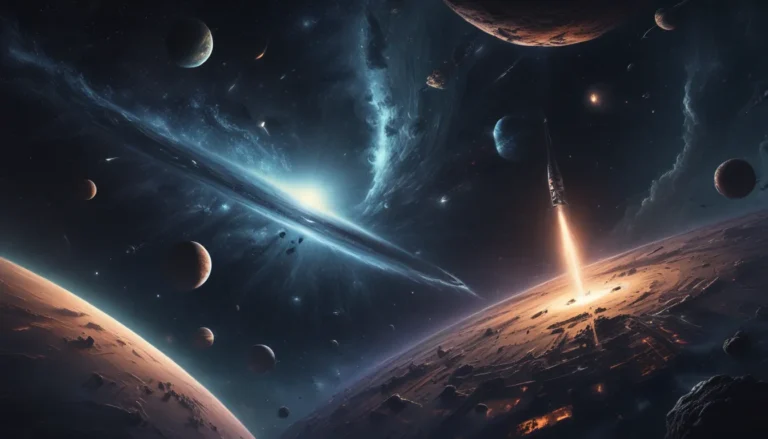The pictures we use in our articles might not show exactly what the words say. We choose these pictures to make you interested in reading more. The pictures work together with the words but don’t take their place. The words still tell you the important facts.
The realm of galactic evolution holds a captivating allure for astronomy enthusiasts, offering a glimpse into the intricate processes that have shaped the cosmos over billions of years. From the birth of galaxies to their mergers and interactions, each stage unravels a mesmerizing tale of transformation and growth. Join us as we explore 10 extraordinary facts about galactic evolution, delving into the cosmic dance that has sculpted our celestial neighborhood.
Galactic Evolution Unveiled
Galaxies, the cosmic shape-shifters, are in a perpetual state of evolution, constantly changing and growing through a myriad of transformative processes. From the formation of the first galaxies billions of years ago to the present-day mergers and interactions, galaxies serve as a canvas upon which the fundamental forces of the universe play out.
Galactic Mergers: A Cosmic Ballet
The merging of galaxies stands as a key mechanism driving galactic evolution, reshaping the cosmic landscape with each gravitational embrace. When galaxies collide, they give rise to new, larger structures, altering their composition and distribution of stars and gas in the process. These mergers are not mere collisions but dynamic interplays that fuel the evolution of galaxies.
The Enigmatic Role of Supermassive Black Holes
At the hearts of most galaxies lie supermassive black holes, enigmatic entities that wield immense influence during galactic evolution. These cosmic behemoths can trigger the growth of galaxies through the accretion of matter, unleashing prodigious energy through active galactic nuclei and quasars. Their presence shapes the destiny of their host galaxies in profound ways.
Stellar Spectacles: Galactic Collisions and Star Formation
Galactic collisions are celestial spectacles that trigger intense bursts of star formation, breathing new life into galaxies as they interact and merge. The gravitational forces unleashed during these encounters compress gas, igniting the formation of new stars and rejuvenating older systems. It is through these cosmic dances that galaxies evolve and renew themselves.
Embracing Galactic Cannibalism
Galactic cannibalism, a common phenomenon in the cosmic realm, sees larger galaxies consuming their smaller counterparts. As galaxies interact and merge, the more massive entity devours the smaller one, altering its composition and increasing its size. This process of galactic dining plays a pivotal role in shaping the evolution of galaxies.
Unveiling the Influence of Dark Matter
Dark matter, the enigmatic substance that eludes direct detection, exerts a gravitational pull on visible matter within galaxies, shaping their structure and distribution. This invisible force plays a vital role in the evolution of galaxies, influencing the formation of stars, gas clouds, and the overall architecture of cosmic structures.
Cosmic Rhythms: Galactic Dormancy
While galaxies are renowned for their dynamic nature, they also experience periods of relative quiet known as galactic dormancy. During these phases, star formation ebbs, and galactic activity wanes, offering a respite from the intense bursts of evolution. These tranquil interludes are integral to the overall regulation of galactic growth and evolution.
A Tapestry of Shapes: Galactic Diversity Revealed
The diverse shapes of galaxies, from the spiral arms of majestic spirals to the smooth contours of elliptical galaxies, hint at their evolutionary histories. Each shape represents a unique evolutionary path shaped by interactions, mergers, and internal processes that have unfolded over billions of years.
Cosmic Collisions: The Birth of Galactic Nuclei
When galaxies collide, the central regions can give rise to galactic nuclei, compact regions teeming with stars and active galactic nuclei. These dense concentrations of energy and matter are thought to be the epicenters of some of the most energetic events in the universe, shaping the evolution of galaxies.
A Cosmic Tapestry: The Interconnected Nature of Galactic Evolution
Galactic evolution is not a solitary pursuit but an integral part of the larger cosmic evolution that shapes the universe. The formation and development of galaxies are intricately linked to the expansion of the cosmos, the evolution of dark matter and energy, and the overarching growth and structure of the cosmic web that binds us all.
Unraveling the Mysteries of Galactic Evolution
As we navigate the vast expanse of galactic evolution, we uncover the secrets of magnetic field generation and delve into the enigmatic realm of Messier 82 M82, a galaxy that offers a window into the cosmic marvels that await exploration. Through each discovery, we deepen our understanding of the universe and our place within its infinite tapestry.
Conclusion
The journey through the wonders of galactic evolution unveils a universe filled with awe-inspiring beauty and complexity. From the intricate ballet of galactic mergers to the cosmic dances of star formation, each revelation showcases the grandeur and diversity of the cosmos. As we continue to unravel the mysteries that lie beyond our celestial neighborhood, we embrace the boundless possibilities that await discovery in the cosmic expanse.
FAQs
-
What is galactic evolution?
Galactic evolution refers to the changes and transformations that occur within galaxies over time, encompassing processes such as star formation, galaxy mergers, and interactions between cosmic structures. -
How do galaxies form?
Galaxies form when massive clouds of gas and dust condense under the force of gravity, clumping together to form stars and stellar systems that comprise a galaxy. -
Are all galaxies the same?
No, galaxies exhibit a wide range of shapes and sizes, with spiral galaxies boasting distinct arms and elliptical galaxies featuring rounded structures, each indicative of their unique evolutionary paths. -
Can galaxies die?
While galaxies do not technically "die," they can enter states of galactic quenching, where they cease to form new stars due to factors such as gas depletion or strong galactic winds. -
How do scientists study galactic evolution?
Scientists study galactic evolution through various methods, including telescope observations, computer simulations, and spectroscopic analyses of galaxy composition and structure. -
How does galactic evolution affect life?
Galactic evolution influences the environment in which life can potentially exist, determining the availability of essential elements, the formation of star systems, and the presence of planetary systems conducive to life. -
Can galaxies evolve differently?
Yes, galaxies can evolve along distinct paths based on factors such as gas content, interactions with other galaxies, and the influence of supermassive black holes at their centers, leading to diverse evolutionary outcomes. -
How long does galactic evolution take?
Galactic evolution unfolds over vast timescales, spanning billions of years, and involves gradual changes in the structure and composition of galaxies driven by a complex interplay of astronomical phenomena. -
Are galaxies always in motion?
Yes, galaxies are in constant motion, rotating, orbiting other galaxies, and moving within larger galaxy clusters under the influence of gravitational forces, contributing to the dynamic nature of the cosmic tapestry. -
What causes galaxies to merge?
Galaxies merge due to gravitational interactions that bring them into close proximity, resulting in mutual attraction and eventual merging, leading to the formation of new, larger galaxies that reshape the cosmic landscape.
Unveiling Cosmic Marvels
As we gaze upon the marvels of galactic evolution, we witness the beauty and complexity of the cosmic symphony that plays out across the universe. Each discovery, each revelation, expands our understanding of the intricate forces that govern the evolution of galaxies and the vast expanse of the cosmos. Join us on this cosmic journey, where the wonders of the universe await exploration, inviting us to delve deeper into the mysteries that lie beyond our celestial horizon.






